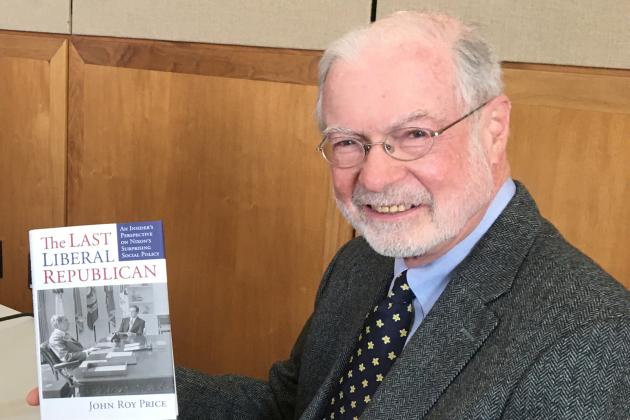PARTICIPANTS
Arthur Brooks, Scott Atlas, Michael Boskin, Mark Duggan, Niall Ferguson, Mo Fiorina, Paul Gregory, Steve Haber, Rick Hanushek, Laurie Hodrick, Bob Hodrick, Ken Judd, Dan Kessler, Stephen Langlois, John Raisian, Josh Rauh, Amit Seru, George Shultz, John Taylor.
ISSUES DISCUSSED
TALK
Arthur Brooks, president of the American Enterprise Institute (AEI), gave a talk on “Bringing America Back Together.” He started by arguing that the degree of polarization in America has reached unprecedented proportions. He suggested that institutions such as Hoover and AEI have an intellectual and moral responsibility to advocate the ideas on which they were formed. He believed that if such ideas were applied, the broad-based economic growth that would follow would take America away from the polarized situation it finds itself in right now.
Dr. Brooks started by noting that what America is facing currently can be understood by synthesizing two pieces of academic research. First, research by Reinhart and Rogoff has shown that financial crises – like the one America experienced in 2008 – often take a long time to clear. Moreover, it is the lower end of the income distribution that faces more severe consequences in such crises. Second, there is research by Manuel Funke and coauthors which suggests that nationalistic populism rises after long crises. Dr. Brooks argued that these phenomena explain the situation America finds itself in right now: a long recession induced by a financial crisis and a populist political reaction to the fallout.
Dr. Brooks contended that the way out must rely on doubling down on economic policies that generate stronger, more even growth. Such policies, when implemented appropriately would bring economic benefits to bottom income quintile – giving them the tools to dig themselves out of poverty – while also lifting the fortunes of the middle three quintiles, thereby “bringing America back together”. In discussing implementation, Dr. Brooks advocated for policies that would rely on less government intervention – lower taxes, fewer regulations, better education and training programs etc. – rather than policies that would redistribute without any vision.
In discussing growth centric policies, Dr. Brooks discussed the moral/cultural aspect behind the objective of such policies. He discussed that the main objective of such policies should be to provide jobs that lead to “dignity” for anyone with a job. He argued that the past policies from government that tried to help the lower income quintiles had not helped eradicate poverty as they intended to. Instead, they ended up inducing a culture of making not working more acceptable among the lower income quintiles, with the result being a large segment of the American population that felt superfluous and disconnected.
Dr. Brooks suggested changing the metric on which policies need to be evaluated for success: Do policies make the targeted more or less necessary to meet the needs of the American economy through their work? He argued that on this dimension, the past government efforts to help fight the poverty, such as the War on Poverty started by Lyndon Johnson in 1964 had been a complete failure.
Going forward, Dr. Brooks argued for better educational and vocational training and better tax and regulatory policy. This he suggested would lead to many in the lower income quintiles becoming “necessary” to the American economy through their ability to join the workforce with dignity.
OPEN DISCUSSION
John Taylor pointed out that the U.S. typically recovered from financial crises much more quickly than other countries and that the slow recovery since the last financial crisis was an anomaly likely caused by bad policy. He raised the importance of studying what policies are helpful and what policies are harmful when a country has suffered a financial crisis.
Rick Hanushek pointed out that the structural gap between unskilled and skilled takes time, particularly for workers that have not recently been through formal education or training. Dr. Brooks gave the example that there are currently 300,000 unfilled positions as welders in the U.S., and that a welder can be trained in 5 months if educational and vocational centers operate efficiently. However, Dr. Hanushek pointed out that the Department of Labor has tried retraining programs since the 1960s even with 20-25 year olds, and these programs have not been successful.
Dan Kessler raised the point that given skill-biased technological change and health cost growth that has left the poor and middle class behind, many would call for more income transfers than we had previously – since if the previous levels of income transfer were optimal for that economic regime, more would certainly be called for in a regime that was less favorable to the poor and middle class. Dr. Brooks argued that income inequality can be borne as long as equality of opportunity is perceived, but also declared himself a proponent of a strong social safety net as a principal capitalism.
Secretary Shultz related an example from Johnson administration, in which a taskforce he himself led recommended that major U.S. companies commit to hiring unemployed people living in inner cities. With the support of President Johnson, the federal government implemented this initiative, and a consortium of major U.S. companies including Ford signed on. Secretary Shultz maintained that the program worked well for several years, but that ultimately such programmatic solutions are hard to sustain. The targeted population lacked skills and a work ethic. Without an economic system that has its own momentum, it is difficult to address these problems. Dr. Brooks reaffirmed that subsidizing idleness attenuates individual dignity, and that policies needed to be put in place that make work pay. Secretary Shultz also suggested that a problem with government is that it no longer attracts the best human capital (“A players”), due to red tape and the difficulty of getting appointees confirmed.
Michael Boskin characterized the federal government’s approach as heaping programs upon failing programs. The problem of large numbers of young men being without gainful employment or meaningful activity was very real, but there has been a lack of accountability as regards the outcomes these programs achieve. How this is to be implemented in such a polarized political environment remains a serious challenge.









